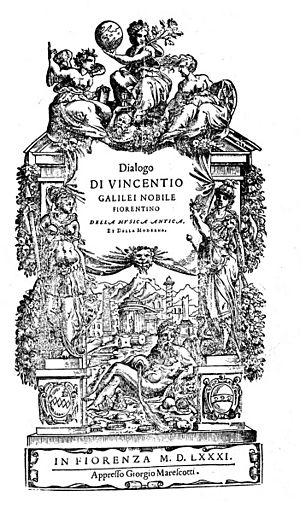Vincenzo Galilei facts for kids
Vincenzo Galilei (born 3 April 1520, Santa Maria a Monte, Italy; died 2 July 1591, Florence, Italy) was an Italian musician. He played the lute, composed music, and studied music theory. He was the father of the famous astronomer and physicist Galileo Galilei. His other son, Michelagnolo Galilei, was also a skilled lute player and composer.
Vincenzo Galilei was an important figure in music during the late Renaissance period. He helped start the musical changes that led to the Baroque era. He also made a very early discovery in science. He described how the pitch of a string changes with its tension using a mathematical rule. This was one of the first times someone used math to describe a natural event.
Many experts believe Vincenzo encouraged his son Galileo to learn through experiments. He taught Galileo to use math to describe what he observed. This way of thinking was very important for the history of physics and natural science.
Early Life and Family
Vincenzo Galilei was born around 1520 in Santa Maria a Monte, a town in Tuscany, Italy. He started learning to play the lute when he was young. Before 1562, he moved to Pisa. There, on July 5th, he married Giulia Ammannati, who came from a noble family.
Vincenzo and Giulia had several children. Their oldest son was Galileo Galilei, who became a very famous scientist. Another son, Michelagnolo, born in 1575, also became a talented lute player and composer.
Musical Career and Ideas
Vincenzo Galilei was a very skilled lute player. Early in his life, powerful people noticed his talent and supported him. In 1563, he met Gioseffo Zarlino in Venice. Zarlino was one of the most important music thinkers of the 1500s, and Vincenzo studied with him.
Later, Vincenzo became interested in bringing back ancient Greek music and plays. He joined a group in Florence called the Florentine Camerata. This group included poets, musicians, and thinkers led by Count Giovanni de' Bardi. Vincenzo also worked with Girolamo Mei, who was an expert on ancient Greek music.
Vincenzo Galilei wrote two books of madrigals, which are songs for several voices. He also composed music for the lute. His most important musical works were pieces for voice and lute. These pieces were special because they showed new styles that would become popular in the early Baroque period.
He was also one of the inventors of a musical style called monody. Monody is a type of singing where one voice sings a melody with simple instrument accompaniment. This style was very close to recitative, which is a speech-like way of singing used in opera. Many people believe Vincenzo Galilei helped create recitative for opera.
Music Theory and Science of Sound
Vincenzo Galilei had advanced ideas about tuning musical instruments. He supported a system called equal temperament. This system makes sure that all the half-steps on an instrument are exactly the same size. This idea was similar to what Johann Sebastian Bach would later use in his famous work, The Well-Tempered Clavier. Vincenzo even composed 24 groups of dances, which were like early versions of pieces written in 12 major and 12 minor keys.
He also had modern ideas about dissonance in music. Dissonance happens when notes sound like they clash or are unstable. Vincenzo believed that dissonant notes could be used if the music flowed smoothly. He also described "essential dissonance," like suspensions, which are notes that create tension before resolving to a more stable sound. His ideas helped define how dissonance was used in the Baroque period.
Vincenzo Galilei was one of the first people to study acoustics in a scientific way. Acoustics is the study of sound. He mainly researched the mathematical rules of vibrating strings. His son Galileo helped him with this research. Galileo later told his biographer that his father taught him to test things carefully and measure the results. They even had a basement in their Pisa home with different lengths of lute strings and weights to experiment with.
Vincenzo discovered that the pitch of a string depends on its length. For example, a perfect fifth (a common musical interval) has a length ratio of 3:2. But he also found that pitch changes with the square root of the tension applied to the string. This means if you want to make a string sound a perfect fifth higher, you need to increase the weight pulling on it by a ratio of 9:4, not 3:2.
Later, a scientist named Marin Mersenne continued Vincenzo's work. Mersenne developed the modern law of vibrating strings. Even though Mersenne was very young when Vincenzo died, he regularly communicated with Galileo. Mersenne defended Galileo when he faced problems with the church in 1633. He also did his own experiments to check Galileo's findings and make them more accurate.
See also
 In Spanish: Vincenzo Galilei para niños
In Spanish: Vincenzo Galilei para niños


